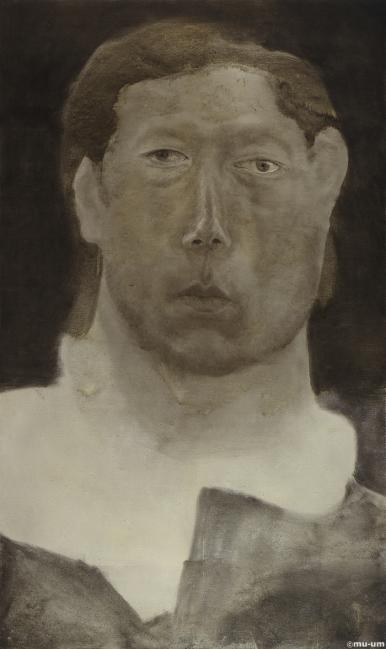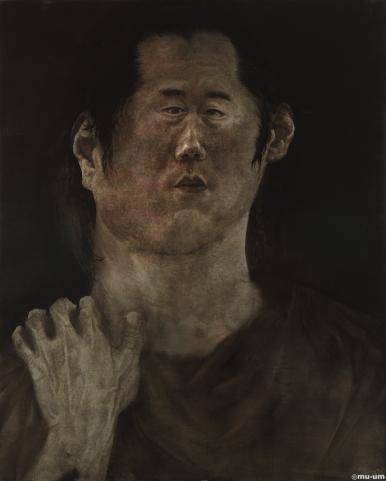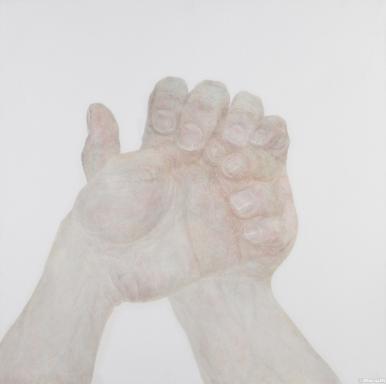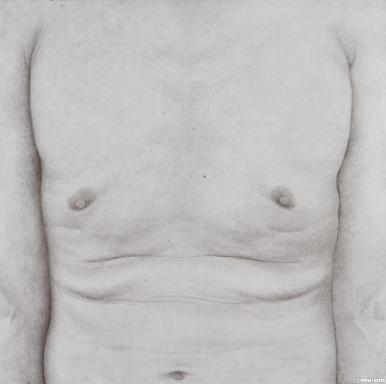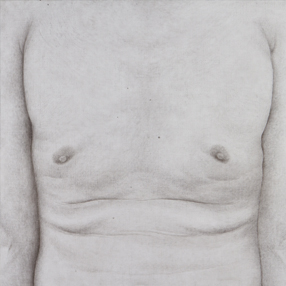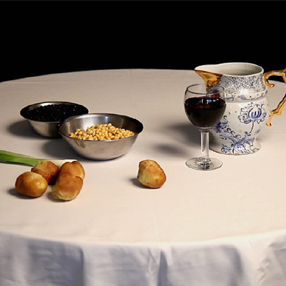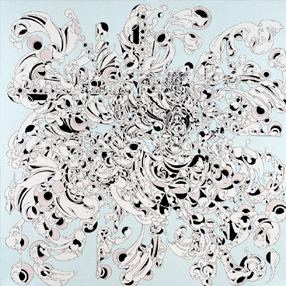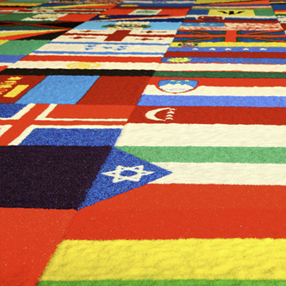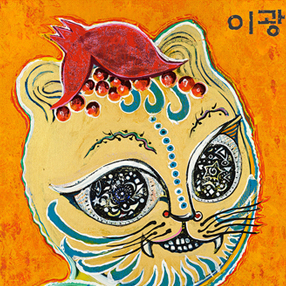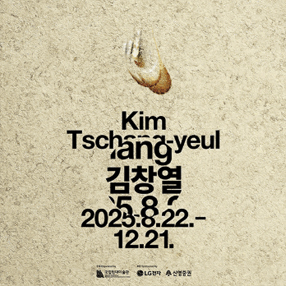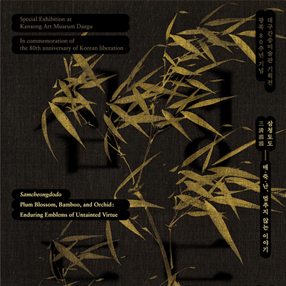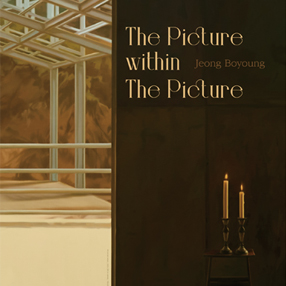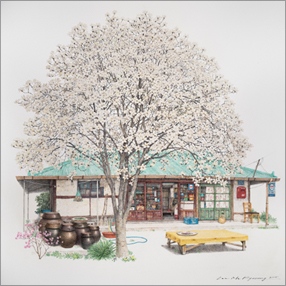본문
-
이우창
얼굴2, oil on canvas, 162x97cm, 2011
-
이우창
얼굴3, oil on canvas, 162x97cm, 2011
-
이우창
얼굴5, oil on canvas, 162x97cm, 2011
-
이우창
품, oil on silk, 17x27.5cm, 2010
-
이우창
품다, oil on canvas, 80x80cm, 2012
-
이우창
품I, oil on canvas, 80x80cm, 2012
-
Press Release
이우창-피부를 품다
박영택(경기대교수, 미술평론)
회화는 피부위에 기생한다. 세계의 피부를 주어진 화면의 표면위로 옮기는 일이 그림이다. 모든 사물과 인간은 자신의 피부만을 보여줄 뿐이기에 회화는 그 피부 너머를 강박적으로 탐하면서 육박한다. 그러나 결국 회화도 납작한 피부위에서만 서식하는 일이기에 그 피부를 떠내면서 그 내부를 열어보이고자 하는 무모한 일을 욕망한다. 따라서 그림은 표면에서 이루어지지만 그 표면을 하나의 통로로 삼아 그 이면을 펼쳐 보여주는 일이다. 사물과 살의 안쪽을 연상하게 하고 그 안으로 들어가는 길을 만들어주는 일이다.
캔버스 표면에 단색의 미묘한 톤으로 인간의 피부를 그리는 이우창의 그림은 얼핏 흑백사진과 그림의 경계를 잠시 헷갈리게 하기도 하고 오일페인팅과 수묵의 가늠도 애매하게 한다. 아울러 그것이 어떤 몸인지, 왜 그 피부에 주목하고 있는지도 잘 잡히지 않는 편이다. 몸에 근접해서, 그 피부에 달라붙어서 뜯어먹는 시선으로 그린 그림이다.
이우창은 분명 실재하는 인물을 그린다. 자기 앞에 놓은 대상에 대한 이 핍진한 시선은 세부에 탐닉하는 눈과 붓질을 보여주면서 동시에 그러한 접근이 역설적으로 대상을 무척이나 낯설고 모호한 존재로 만들어 놓고 있다. 뒷짐을 쥐고 있는 사내의 손, 늘어진 뱃살을 보여주는 남자의 가슴 부위 는 흡사 병원에서 ‘엑스레이’를 찍기 위해 서있거나 진찰을 받기 위해 웃통을 벗고 앉아있는 이의 몸을 연상시키는 포즈다. 그것은 자신을 보는 타자의 시선, 기계의 시선에 무방비로 놓인 몸, 사물화 된 몸과도 같다.
사실을 토대로 이루어지는 그의 회화는 그런 파편화 된 시선에 의한 부분적 접근, 모노톤의 중성적인 색채를 통해 다소 애매한 느낌 등을 전달하려는 것 같다. 구체적인 누군가의 재현이나 묘사와는 분명 다르다. 작가는 자신의 눈으로 직접 보고 느낀 것을 그리지만 그 대상 자체가 아니라 그로부터 연유하는 느낌의 시각화에 주목한다. 비로소 주체와 대상이 만나서 발생하는 감정, 사건, 느낌이 시각화다. 자기 앞에 자리한 인물의 피부를 훑어나가면서 그것이 자아내는 아우라를 그리고자 한다. 그래서 그가 그리는 인물화는 일반적인 인물화와 다르다. 사람의 얼굴생김새를 중심으로 그리기 보다는 부분적으로 접근한 시선, 뜯어먹는 시선으로 피부를 관찰하는데 특히 ‘ 피와 뼈’를 화면에 표현하고자 한다.
그는 고고욕생(枯槁欲生) 혹은 생노병사(生老病死)라는 말을 즐겨 쓴다. 그것이 모든 생명체의 공통된 성향이자 그가 존재를 통해 느낀 것이다. 그 육덕진 것과 현상들에 주목하는데 그것들을 결국 살기위한 본능을 지닌 것들이다. 누군가의 피부를 지도 그리듯이 그리고 지도를 읽어가듯이 독해한다. 피부란 내부를 감싼 막이자 세상의 경계이고 모든 생명체의 외형을 가능하게 하는 지점이다. 그 멈춰있는 대상을 보고 그리면 문득 그 피부의 주인인 생명체의 과거와 미래, 현재가 읽혀진다. 그 피부를 그리다보면 그 피부를 두른 이의 삶의 역사가 다가온다. 그가 살아온 과거와 현재, 미래가 동시에 펼쳐진다. 바로 이 부분에서 그의 그림은 외모와 피부의 핍진한 묘사를 통해 이른바 전신사조에 도달하고자 했던 조선신대 초상화와 만난다. 외모를 통해 정신이 드러나고 그의 생애가 기록된다. 그것이 다름아닌 성리학에서 주창하는 이기일원론에 유사한 것이다. 이우창은 모종의 감정에 사로잡히거나 특정 의도를 가지고 모델에 접근하지 않는다. 그는 그 존재/피부를 보면서 그의 생명체로서의 본능을 그리고자 한다. 그림에는 살 안에 보이는 핏줄, 부드러운 질감 등이 어른거린다. 설명과 표정을 지닌 안면을 배제한 신체만이 풍경처럼 파리하게 자리한다. 부동의 신체, 피부에는 처지고 늘어진 살과 주름, 반점들이 별처럼 흩어져있다. 그렇게 외부로 드러난 조그마한 단서들을 조심스레 그림 안으로 불러들여 한 존재가 지닌 생명체로서의 본능과 생애의 이력을 그림으로 그리고자 한다. 흐릿한 흑백톤으로 마치 회상이나 기억에 잠긴 듯한 신체의 한 부위가 더없이 매혹적이다. 이 낯설고 미지의 것으로 다가오는 슬퍼보이면서도 완강한 피부를 눈과 가슴으로 품어보고자 하는 것이다.
Woo Chang Lee – Embracing the Skin
Young-taek Park (professor of Kyonggi University, art critic)
Painting is parasitic on skin. Painters transfer the world’s skin onto the surface of the canvas. Because every object or man allows others to see only its skin, painters compulsively desire and examine what is beyond there. Because painting is to inhabit on the flat skin after all, painters recklessly covet to cut the skin out and discover the inside. Thus, although a painting is created on the surface, painters try to unfold the hidden aspects by using the surface as a passage. In other words, paintings help us imagine the inner side of the objects and flesh, and create a way for us to enter there.
Woo Chang Lee paints human skin on the surface of the canvas with solid and subtle colors. His paintings momentarily shade the boundary between monochrome photograph and painting, and obscure the distinction between oil painting and ink-and-wash painting. Furthermore, even the identity of the body he depicts and the reason why he gives attention to that particular skin are not clear. His paintings are created by observing the bodies in close distance and adhering to the skins with a gnawing gaze.
Lee paints human beings in esse. His approach, to represent the subject matter standing in front of him as realistic as possible, reflects his gaze and brush strokes indulging in the details. However, this technique turns the subject matter into an extremely unfamiliar and ambiguous existence. The poses, like a man’s hands clasped behind his back and a chest with sagging stomach, remind us of people waiting to take an X-ray or to have a checkup at a hospital with their upper garments off. They symbolize others’ gazes staring at the self, the defenseless body exposed to mechanical eyes, and also the objectified body.
Lee’s paintings, created based on facts, convey somewhat vague feelings by approaching parts, rather than the whole, through fragmented gazes, and using monotonous neutral colors. They are evidently different from representations or depictions of specific people. The artist paints what he saw and felt with his eyes, but the emphasis is not on the subject matter itself, but on the visualization of the senses stemming from his experience with it. The emotions, events, and feelings that emerge from the encounter between the subject and the object are visualized in his works. Measuring a person’s skin with his eyes, the artist attempts to paint the aura generated from the experience. As a result, Lee’s portraits are different from the portraits in general. Rather than depicting a person’s appearance, he observes the skin with gnawing gaze concentrating on parts, and particularly, tries to show the ‘blood and bones’ on the screen.
The artist likes to use the words ‘go-go-yok-saeng (枯槁欲生; wither and born)’ and ‘saeng-ro-byung-sa (生老病死; birth, old age, sickness, and death; the four phases of life)’. He believes that these are the common characteristics of all living things, and experiences them through existence. He notices the fleshness and the relevant phenomena in each living organism which, in the end, possess the instinct to live. He paints one’s skin as if he draws a map, and comprehends the existence as if he reads a map. For Lee, skin is the outer covering that protects the inner, the boundary of the world, and the point where the appearance of every life becomes possible. When he paints an object standing still in front of him, he reads the past, present, and future of the owner of the skin. While painting the skin, the history of the person who lived with the skin comes to the view. The person’s past, present, and future spreads simultaneously. This characteristic of Lee’s paintings resembles that of the portraits in the Joseon Dynasty period where the artists attempted to accomplish ‘jeon-shin-sa-jo (傳神寫照; the expression of one’s spirit through the representation of his appearance, a value emphasized in Oriental portrait) through realistic illustration of the appearance and the skin. One’s mind can be revealed and the life can be recorded through outer appearance. This idea is similar to the ‘li-ki-monolism (理氣一元論; li and ki, the fundamental and phenomenal nature of the universe, respectively, are not separated but essentially the identical) advocated in Neo-Confucianism. Lee does not approach his models with a certain emotional capture or specific intentions. Observing the existence, or the skin, he aims to paint the instinct as a living organism that resides in it. The veins in the flesh and the soft texture waver inside his paintings. Excluding the face, which represents explanations and expressions, only the body wanly takes up the space like a scene. Sagging flesh, drooping wrinkles, and spots scatter like stars on the immovable body and skin. Carefully loading these tiny clues into a picture, the artist paints an existence’s instinct as a living organism as well as the history of one’s life. A part of the body, as its best, seems fascinating as if recalling or remembering the blurry monotone memories. Lee’s works aim to embrace this strange, unknown, sad, and stubborn skin with the artist’s eyes and arms.전시제목이우창 - 품 (Breast)
전시기간2012.05.03(목) - 2012.05.20(일)
참여작가 이우창
관람시간11:00am~18:00pm
휴관일월요일
장르회화와 조각
관람료무료
장소브레인 팩토리 Brain Factory (서울 종로구 통의동 1-6 )
연락처02-725-9520
-
Artists in This Show
-
1977년 출생
-
브레인 팩토리(Brain Factory ) Shows on Mu:umView All
Current Shows
-
먼지를 걷는 자들 Dust Walkers
신한갤러리
2025.11.13 ~ 2025.12.20
-
유리: 투명한 고리
갤러리 학고재
2025.11.19 ~ 2025.12.20
-
이광 개인전 《우주호랑이- 호랑이 여자로 산다는 것은》
갤러리 마리
2025.11.21 ~ 2025.12.20
-
김창열
국립현대미술관
2025.08.22 ~ 2025.12.21
-
삼청도도 三淸滔滔 – 매·죽·난, 멈추지 않는 이야기
대구간송미술관
2025.09.23 ~ 2025.12.21
-
정보영: 그림 속의 그림: The Picture within The Picture
성남큐브미술관
2025.10.24 ~ 2025.12.21
-
Rock, Paper, Scissors: Transformation of Paper
갤러리현대
2025.11.12 ~ 2025.12.21
-
이미경 개인전
갤러리 이마주
2025.12.01 ~ 2025.12.27




